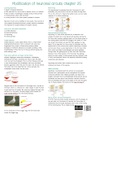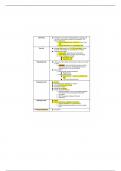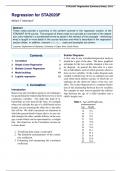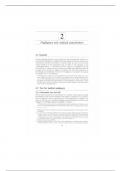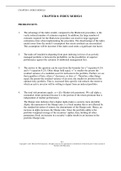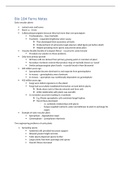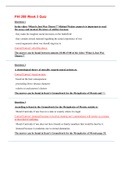Modification of neuronal circuits chapter 25
Learning objectives: Pavlov’s dog
• Innate vs Acquired behaviour This dog learned to associate food with the sound of a bell.
• FAPs important for the survival of species, occur in all animals Eventually, only the sound of the bell can make the dog drool.
• Brain is plastic, morphological changes during critical periods This is not a form of a fixed action pattern and is not an innate
• Critical periods, when, what and how? response. It is called conditioning.
• Critical periods in the visual system, problems in humans
Neuronal circuits can be modified at many levels, this could be at
the synapses (formation/retraction), synaptic plasticity modulates
the response of receptors/release of synaptic vesicles.
There are a few build-in behaviours
1) Innate behaviour
2) Acquired behaviour Acquired behaviour/imprinting
3) Imprinting Imprinting is a hard-wired acquired This is behaviour that
4) Critical periods consists of instinct but is also paired with learning. During the
first day after hatching, goslings imprint on the mother goose or
Innate behaviour any moving object they see first (trigger), this works in a two-
Innate behaviour is also called instinct, this is a “hard-wired” way street, the mothers can also find their goslings in a big
preprogrammed behaviour that is automatic and cannot be heard. This is important for the survival of individuals and the
suppressed. They consist of fixed-action patterns (FAPs). species and to form normal social contact. Imprinting in humans
Examples of instinctive behaviours are spiders building a web, can fail when there is social deprivation in the first year after
breastfeeding, turtles that run to the sea without seeing, and birth which could lead to psychological and social problems.
birds making a nest. Though when the goslings grow up they lose their imprinting
behaviour. The critical period is the time when the goslings
Fixed action patterns and Super normal stimuli imprint on their mother. Critical periods are short periods in life
Nicolaas Tingbergen researched sticklebacks. Sticklebacks in which environmental factors are especially influential shaping
normally do not have a red belly, but twice a year the belly connections and behaviour.
turns red and the stickleback tries to attract females and build
a nest. He discovered that sticklebacks that have red bellies Imprinting and instinct both increase the survival of the
become aggressive when they see the colour red. He also noticed individual and hence of the species.
that when one of his model fish has a more red belly, the
sticklebacks would attack this fish more. Hebb’s postulates
Hypothesis: coordinated electrical activity of a presynaptic
terminal and a postsynaptic neuron strengthens the synaptic
connection between them. Hebb’s postulates also imply that
synaptic terminals that are strengthened during activity will be
maintained and even sprout new branches, whereas thermals
that are weakened will lead to the death of the cell that gives
rise to those synapses. This works via the “use it or lose it”
principle.
Seagulls also do this the mother of the seagull has a red dot on
the beak, which is a stimulus for a baby seagull to open its beak
to get food from its mother. But when you replace the beak with
the dot for a red pencil, the baby seagull would choose this
super normal stimulus over the normal stimulus.
Neural activity and brain development
At birth, there are many neurons and grow a lot of synapses. As
you get older, not the amount of neurons, but the number of
connections that are made, decreases. This is due to fine-tuning
of the brain/muscles, this is called pruning.
If you would give a bird a bigger egg, the bird would also
choose the bigger egg.
Learning objectives: Pavlov’s dog
• Innate vs Acquired behaviour This dog learned to associate food with the sound of a bell.
• FAPs important for the survival of species, occur in all animals Eventually, only the sound of the bell can make the dog drool.
• Brain is plastic, morphological changes during critical periods This is not a form of a fixed action pattern and is not an innate
• Critical periods, when, what and how? response. It is called conditioning.
• Critical periods in the visual system, problems in humans
Neuronal circuits can be modified at many levels, this could be at
the synapses (formation/retraction), synaptic plasticity modulates
the response of receptors/release of synaptic vesicles.
There are a few build-in behaviours
1) Innate behaviour
2) Acquired behaviour Acquired behaviour/imprinting
3) Imprinting Imprinting is a hard-wired acquired This is behaviour that
4) Critical periods consists of instinct but is also paired with learning. During the
first day after hatching, goslings imprint on the mother goose or
Innate behaviour any moving object they see first (trigger), this works in a two-
Innate behaviour is also called instinct, this is a “hard-wired” way street, the mothers can also find their goslings in a big
preprogrammed behaviour that is automatic and cannot be heard. This is important for the survival of individuals and the
suppressed. They consist of fixed-action patterns (FAPs). species and to form normal social contact. Imprinting in humans
Examples of instinctive behaviours are spiders building a web, can fail when there is social deprivation in the first year after
breastfeeding, turtles that run to the sea without seeing, and birth which could lead to psychological and social problems.
birds making a nest. Though when the goslings grow up they lose their imprinting
behaviour. The critical period is the time when the goslings
Fixed action patterns and Super normal stimuli imprint on their mother. Critical periods are short periods in life
Nicolaas Tingbergen researched sticklebacks. Sticklebacks in which environmental factors are especially influential shaping
normally do not have a red belly, but twice a year the belly connections and behaviour.
turns red and the stickleback tries to attract females and build
a nest. He discovered that sticklebacks that have red bellies Imprinting and instinct both increase the survival of the
become aggressive when they see the colour red. He also noticed individual and hence of the species.
that when one of his model fish has a more red belly, the
sticklebacks would attack this fish more. Hebb’s postulates
Hypothesis: coordinated electrical activity of a presynaptic
terminal and a postsynaptic neuron strengthens the synaptic
connection between them. Hebb’s postulates also imply that
synaptic terminals that are strengthened during activity will be
maintained and even sprout new branches, whereas thermals
that are weakened will lead to the death of the cell that gives
rise to those synapses. This works via the “use it or lose it”
principle.
Seagulls also do this the mother of the seagull has a red dot on
the beak, which is a stimulus for a baby seagull to open its beak
to get food from its mother. But when you replace the beak with
the dot for a red pencil, the baby seagull would choose this
super normal stimulus over the normal stimulus.
Neural activity and brain development
At birth, there are many neurons and grow a lot of synapses. As
you get older, not the amount of neurons, but the number of
connections that are made, decreases. This is due to fine-tuning
of the brain/muscles, this is called pruning.
If you would give a bird a bigger egg, the bird would also
choose the bigger egg.


